heating Alfa Romeo Giulia 2016 Owner's Manual
[x] Cancel search | Manufacturer: ALFA ROMEO, Model Year: 2016, Model line: Giulia, Model: Alfa Romeo Giulia 2016Pages: 204, PDF Size: 4.95 MB
Page 21 of 204
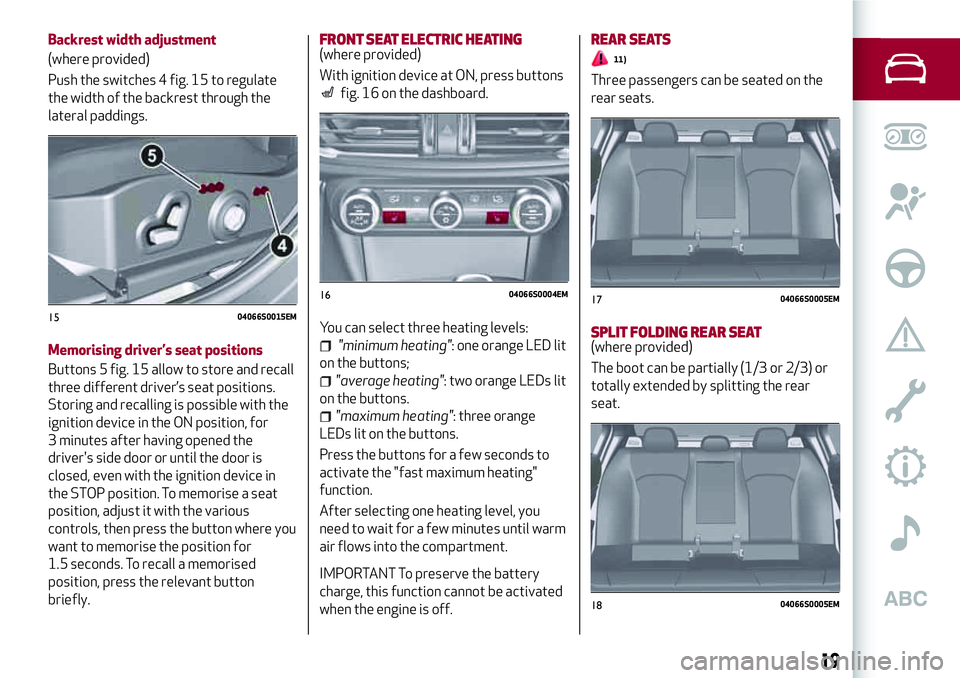
Backrest width adjustment
(where provided)
Push the switches 4 fig. 15 to regulate
the width of the backrest through the
lateral paddings.
Memorising driver’s seat positions
Buttons 5 fig. 15 allow to store and recall
three different driver’s seat positions.
Storing and recalling is possible with the
ignition device in the ON position, for
3 minutes after having opened the
driver's side door or until the door is
closed, even with the ignition device in
the STOP position. To memorise a seat
position, adjust it with the various
controls, then press the button where you
want to memorise the position for
1.5 seconds. To recall a memorised
position, press the relevant button
briefly.FRONT SEAT ELECTRIC HEATING(where provided)
With ignition device at ON, press buttons
fig. 16 on the dashboard.
You can select three heating levels:
"minimum heating": one orange LED lit
on the buttons;
"average heating": two orange LEDs lit
on the buttons.
"maximum heating": three orange
LEDs lit on the buttons.
Press the buttons for a few seconds to
activate the "fast maximum heating"
function.
After selecting one heating level, you
need to wait for a few minutes until warm
air flows into the compartment.
IMPORTANT To preserve the battery
charge, this function cannot be activated
when the engine is off.REAR SEATS
11)
Three passengers can be seated on the
rear seats.
SPLIT FOLDING REAR SEAT(where provided)
The boot can be partially (1/3 or 2/3) or
totally extended by splitting the rear
seat.
1504066S0015EM
1604066S0004EM1704066S0005EM
1804066S0005EM
19
Page 24 of 204

STEERING WHEEL
14) 15)
ADJUSTMENTS
The steering wheel can be adjusted both
in height and in depth.
To adjust the position bring the lever 1
fig. 23 down to position A after which the
steering wheel can be adjusted to the
most suitable position and subsequently
locked in this position by bringing lever
1 to position B again.
ELECTRIC STEERING WHEEL HEATING(where provided)
With ignition device at ON, press the
fig. 24 button on the air conditioner
control panel.
When the function is enabled, the LED on
the button switches on.
IMPORTANT If this function is activated
with the engine stopped the battery may
run down.
WARNING
14)All adjustments must be carried out only
with the car stationary and engine stopped.15)It is absolutely forbidden to carry out
any after-market operation involving
steering system or steering column
modifications (e.g. installation of anti-theft
device) that could adversely affect
performance, invalidate the warranty, cause
SERIOUS SAFETY PROBLEMS and also
result in the car not meeting type-approval
requirements.2304086S0001EM
2404086S0002EM
22
KNOWING YOUR CAR
Page 40 of 204

CONTROL PANEL AND ON-BOARD INSTRUMENTS
3.5” TFT DISPLAY
1. Rev counter 2. Digital engine oil temperature gauge with overheating warning light 3. TFT Display 4. Digital fuel level
gauge (the triangle on the left side of the symbol indicates the side of the vehicle with the fuel filler) 5. Speedometer (speed
indicator)
4305026S0001EM
38
KNOWING THE INSTRUMENT PANEL
Page 41 of 204
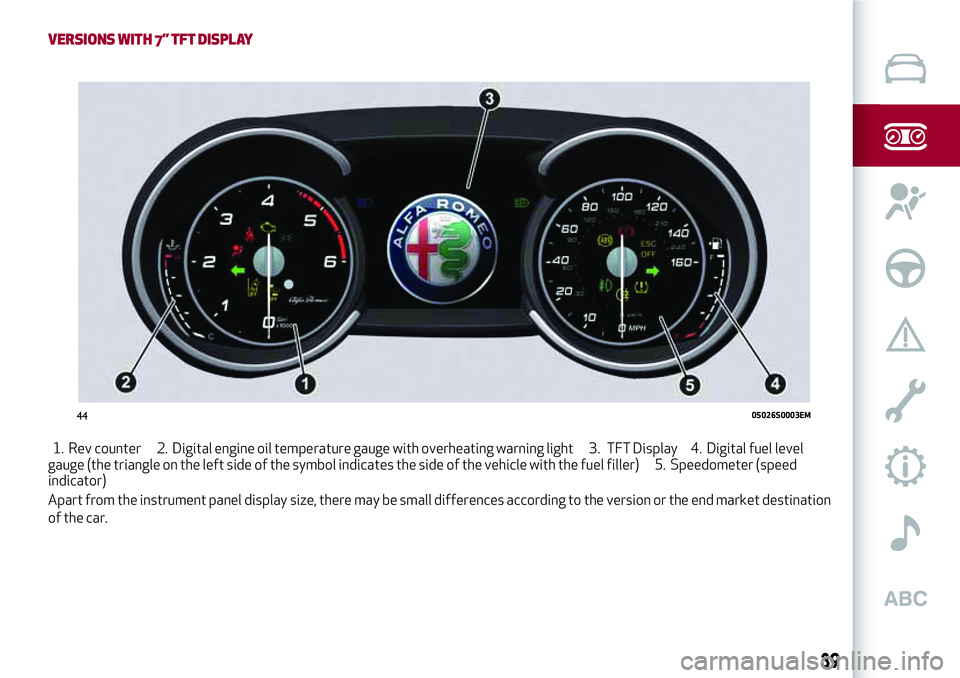
VERSIONS WITH 7” TFT DISPLAY
1. Rev counter 2. Digital engine oil temperature gauge with overheating warning light 3. TFT Display 4. Digital fuel level
gauge (the triangle on the left side of the symbol indicates the side of the vehicle with the fuel filler) 5. Speedometer (speed
indicator)
Apart from the instrument panel display size, there may be small differences according to the version or the end market destination
of the car.
4405026S0003EM
39
Page 51 of 204
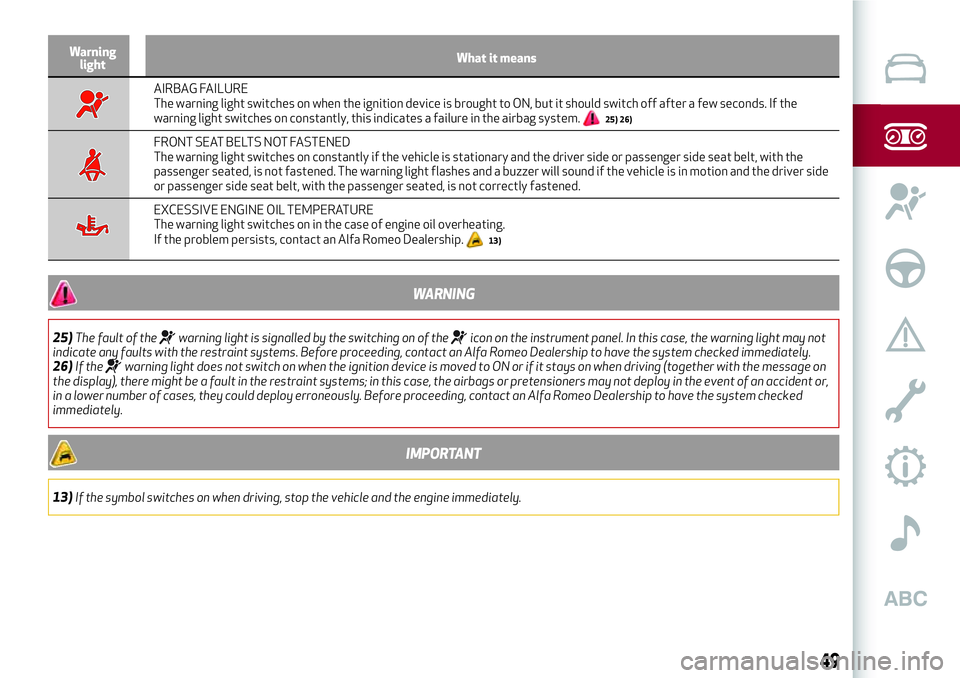
Warning
lightWhat it means
AIRBAG FAILURE
The warning light switches on when the ignition device is brought to ON, but it should switch off after a few seconds. If the
warning light switches on constantly, this indicates a failure in the airbag system.
25) 26)
FRONT SEAT BELTS NOT FASTENED
The warning light switches on constantly if the vehicle is stationary and the driver side or passenger side seat belt, with the
passenger seated, is not fastened. The warning light flashes and a buzzer will sound if the vehicle is in motion and the driver side
or passenger side seat belt, with the passenger seated, is not correctly fastened.
EXCESSIVE ENGINE OIL TEMPERATURE
The warning light switches on in the case of engine oil overheating.
If the problem persists, contact an Alfa Romeo Dealership.
13)
WARNING
25)The fault of thewarning light is signalled by the switching on of theicon on the instrument panel. In this case, the warning light may not
indicate any faults with the restraint systems. Before proceeding, contact an Alfa Romeo Dealership to have the system checked immediately.
26)If the
warning light does not switch on when the ignition device is moved to ON or if it stays on when driving (together with the message on
the display), there might be a fault in the restraint systems; in this case, the airbags or pretensioners may not deploy in the event of an accident or,
in a lower number of cases, they could deploy erroneously. Before proceeding, contact an Alfa Romeo Dealership to have the system checked
immediately.
IMPORTANT
13)If the symbol switches on when driving, stop the vehicle and the engine immediately.
49
Page 59 of 204
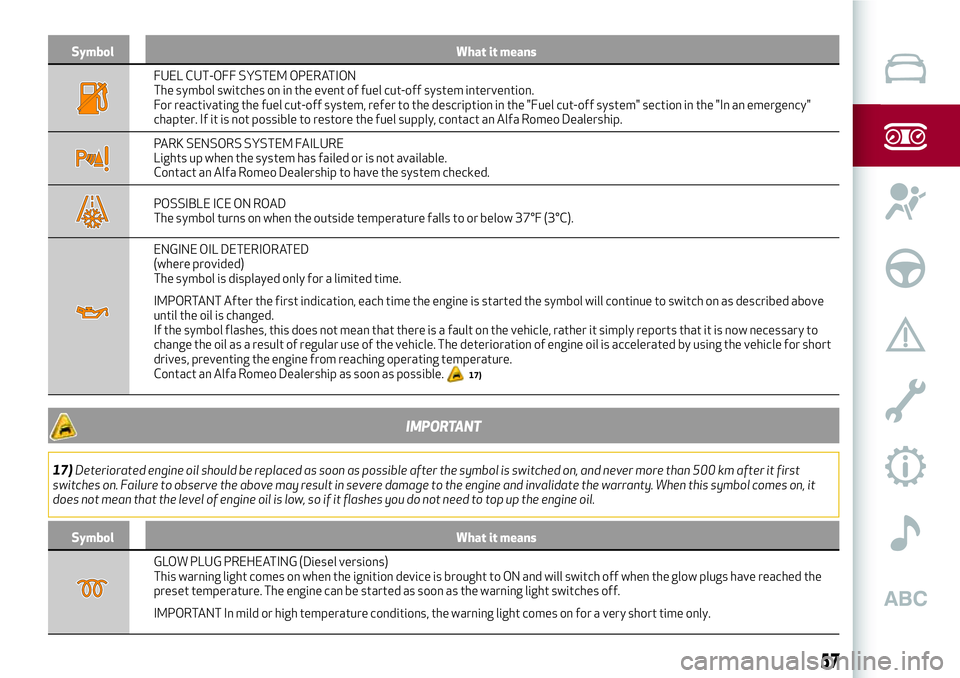
Symbol What it means
FUEL CUT-OFF SYSTEM OPERATION
The symbol switches on in the event of fuel cut-off system intervention.
For reactivating the fuel cut-off system, refer to the description in the "Fuel cut-off system" section in the "In an emergency"
chapter. If it is not possible to restore the fuel supply, contact an Alfa Romeo Dealership.
PARK SENSORS SYSTEM FAILURE
Lights up when the system has failed or is not available.
Contact an Alfa Romeo Dealership to have the system checked.
POSSIBLE ICE ON ROAD
The symbol turns on when the outside temperature falls to or below 37°F (3°C).
ENGINE OIL DETERIORATED
(where provided)
The symbol is displayed only for a limited time.
IMPORTANT After the first indication, each time the engine is started the symbol will continue to switch on as described above
until the oil is changed.
If the symbol flashes, this does not mean that there is a fault on the vehicle, rather it simply reports that it is now necessary to
change the oil as a result of regular use of the vehicle. The deterioration of engine oil is accelerated by using the vehicle for short
drives, preventing the engine from reaching operating temperature.
Contact an Alfa Romeo Dealership as soon as possible.
17)
IMPORTANT
17)Deteriorated engine oil should be replaced as soon as possible after the symbol is switched on, and never more than 500 km after it first
switches on. Failure to observe the above may result in severe damage to the engine and invalidate the warranty. When this symbol comes on, it
does not mean that the level of engine oil is low, so if it flashes you do not need to top up the engine oil.
Symbol What it means
GLOW PLUG PREHEATING (Diesel versions)
This warning light comes on when the ignition device is brought to ON and will switch off when the glow plugs have reached the
preset temperature. The engine can be started as soon as the warning light switches off.
IMPORTANT In mild or high temperature conditions, the warning light comes on for a very short time only.
57
Page 60 of 204
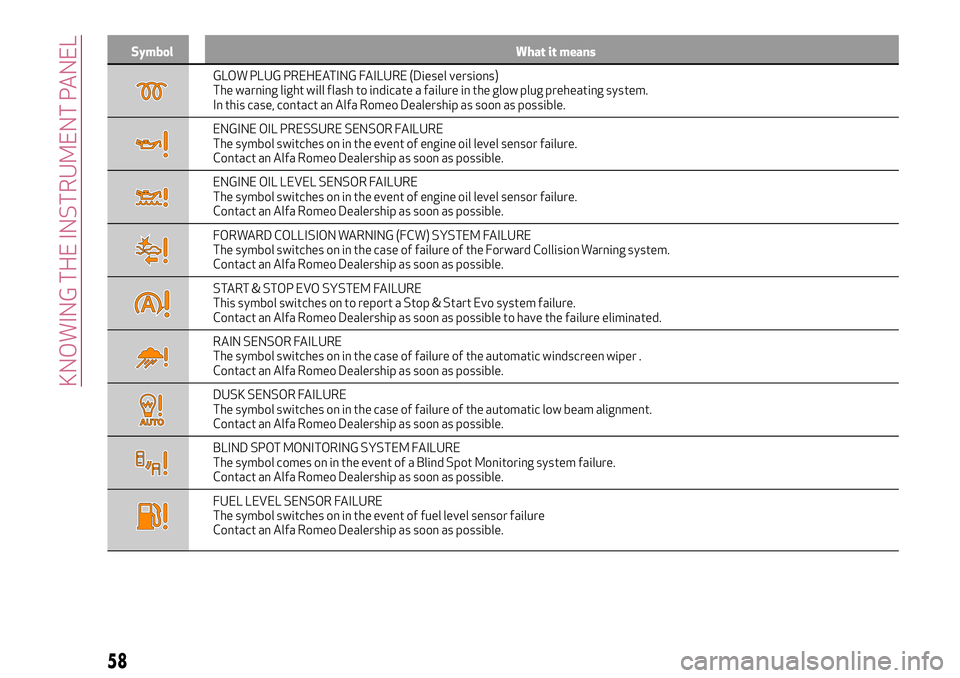
Symbol What it means
GLOW PLUG PREHEATING FAILURE (Diesel versions)
The warning light will flash to indicate a failure in the glow plug preheating system.
In this case, contact an Alfa Romeo Dealership as soon as possible.
ENGINE OIL PRESSURE SENSOR FAILURE
The symbol switches on in the event of engine oil level sensor failure.
Contact an Alfa Romeo Dealership as soon as possible.
ENGINE OIL LEVEL SENSOR FAILURE
The symbol switches on in the event of engine oil level sensor failure.
Contact an Alfa Romeo Dealership as soon as possible.
FORWARD COLLISION WARNING (FCW) SYSTEM FAILURE
The symbol switches on in the case of failure of the Forward Collision Warning system.
Contact an Alfa Romeo Dealership as soon as possible.
START & STOP EVO SYSTEM FAILURE
This symbol switches on to report a Stop & Start Evo system failure.
Contact an Alfa Romeo Dealership as soon as possible to have the failure eliminated.
RAIN SENSOR FAILURE
The symbol switches on in the case of failure of the automatic windscreen wiper .
Contact an Alfa Romeo Dealership as soon as possible.
DUSK SENSOR FAILURE
The symbol switches on in the case of failure of the automatic low beam alignment.
Contact an Alfa Romeo Dealership as soon as possible.
BLIND SPOT MONITORING SYSTEM FAILURE
The symbol comes on in the event of a Blind Spot Monitoring system failure.
Contact an Alfa Romeo Dealership as soon as possible.
FUEL LEVEL SENSOR FAILURE
The symbol switches on in the event of fuel level sensor failure
Contact an Alfa Romeo Dealership as soon as possible.
58
KNOWING THE INSTRUMENT PANEL
Page 62 of 204
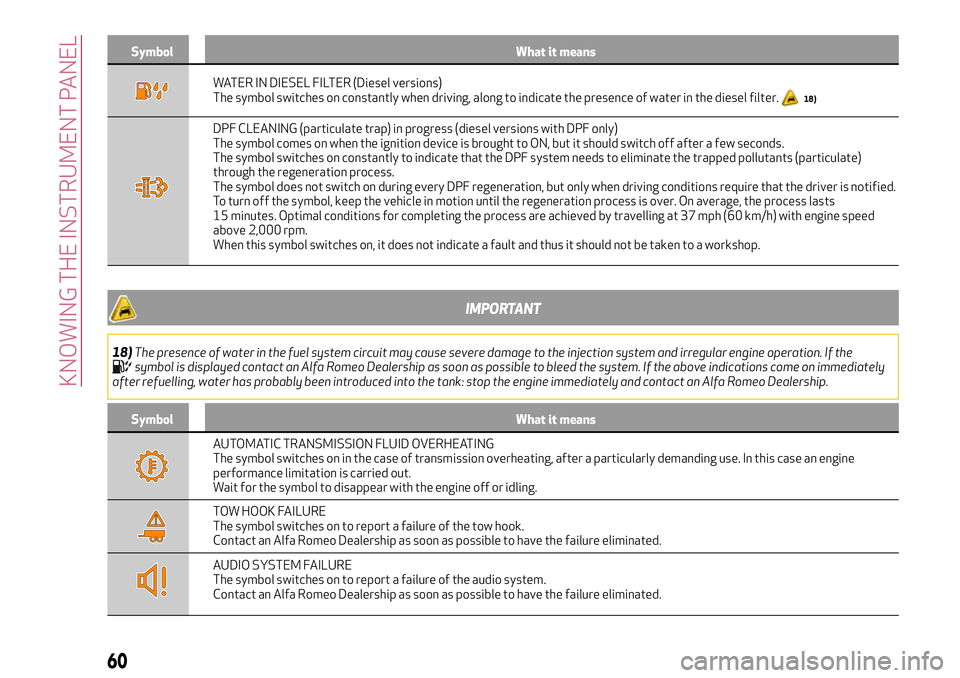
Symbol What it means
WATER IN DIESEL FILTER (Diesel versions)
The symbol switches on constantly when driving, along to indicate the presence of water in the diesel filter.18)
DPF CLEANING (particulate trap) in progress (diesel versions with DPF only)
The symbol comes on when the ignition device is brought to ON, but it should switch off after a few seconds.
The symbol switches on constantly to indicate that the DPF system needs to eliminate the trapped pollutants (particulate)
through the regeneration process.
The symbol does not switch on during every DPF regeneration, but only when driving conditions require that the driver is notified.
To turn off the symbol, keep the vehicle in motion until the regeneration process is over. On average, the process lasts
15 minutes. Optimal conditions for completing the process are achieved by travelling at 37 mph (60 km/h) with engine speed
above 2,000 rpm.
When this symbol switches on, it does not indicate a fault and thus it should not be taken to a workshop.
IMPORTANT
18)The presence of water in the fuel system circuit may cause severe damage to the injection system and irregular engine operation. If thesymbol is displayed contact an Alfa Romeo Dealership as soon as possible to bleed the system. If the above indications come on immediately
after refuelling, water has probably been introduced into the tank: stop the engine immediately and contact an Alfa Romeo Dealership.
Symbol What it means
AUTOMATIC TRANSMISSION FLUID OVERHEATING
The symbol switches on in the case of transmission overheating, after a particularly demanding use. In this case an engine
performance limitation is carried out.
Wait for the symbol to disappear with the engine off or idling.
TOW HOOK FAILURE
The symbol switches on to report a failure of the tow hook.
Contact an Alfa Romeo Dealership as soon as possible to have the failure eliminated.
AUDIO SYSTEM FAILURE
The symbol switches on to report a failure of the audio system.
Contact an Alfa Romeo Dealership as soon as possible to have the failure eliminated.
60
KNOWING THE INSTRUMENT PANEL
Page 77 of 204
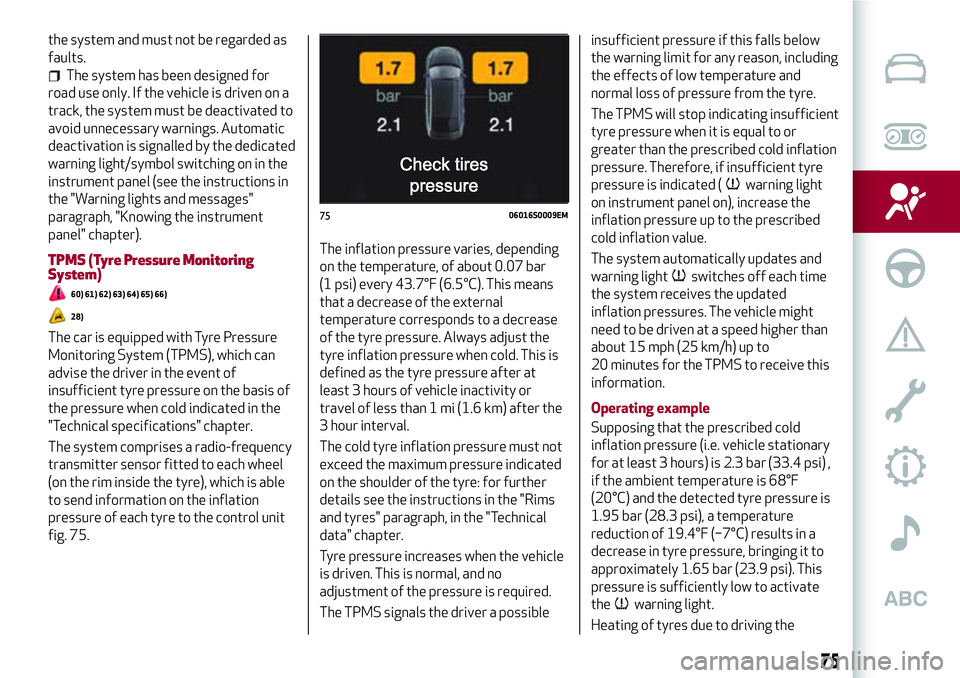
the system and must not be regarded as
faults.
The system has been designed for
road use only. If the vehicle is driven on a
track, the system must be deactivated to
avoid unnecessary warnings. Automatic
deactivation is signalled by the dedicated
warning light/symbol switching on in the
instrument panel (see the instructions in
the "Warning lights and messages"
paragraph, "Knowing the instrument
panel" chapter).
TPMS (Tyre Pressure Monitoring
System)
60) 61) 62) 63) 64) 65) 66)
28)
The car is equipped with Tyre Pressure
Monitoring System (TPMS), which can
advise the driver in the event of
insufficient tyre pressure on the basis of
the pressure when cold indicated in the
"Technical specifications" chapter.
The system comprises a radio-frequency
transmitter sensor fitted to each wheel
(on the rim inside the tyre), which is able
to send information on the inflation
pressure of each tyre to the control unit
fig. 75.The inflation pressure varies, depending
on the temperature, of about 0.07 bar
(1 psi) every 43.7°F (6.5°C). This means
that a decrease of the external
temperature corresponds to a decrease
of the tyre pressure. Always adjust the
tyre inflation pressure when cold. This is
defined as the tyre pressure after at
least 3 hours of vehicle inactivity or
travel of less than 1 mi (1.6 km) after the
3 hour interval.
The cold tyre inflation pressure must not
exceed the maximum pressure indicated
on the shoulder of the tyre: for further
details see the instructions in the "Rims
and tyres" paragraph, in the "Technical
data" chapter.
Tyre pressure increases when the vehicle
is driven. This is normal, and no
adjustment of the pressure is required.
The TPMS signals the driver a possibleinsufficient pressure if this falls below
the warning limit for any reason, including
the effects of low temperature and
normal loss of pressure from the tyre.
The TPMS will stop indicating insufficient
tyre pressure when it is equal to or
greater than the prescribed cold inflation
pressure. Therefore, if insufficient tyre
pressure is indicated (
warning light
on instrument panel on), increase the
inflation pressure up to the prescribed
cold inflation value.
The system automatically updates and
warning light
switches off each time
the system receives the updated
inflation pressures. The vehicle might
need to be driven at a speed higher than
about 15 mph (25 km/h) up to
20 minutes for the TPMS to receive this
information.
Operating example
Supposing that the prescribed cold
inflation pressure (i.e. vehicle stationary
for at least 3 hours) is 2.3 bar (33.4 psi) ,
if the ambient temperature is 68°F
(20°C) and the detected tyre pressure is
1.95 bar (28.3 psi), a temperature
reduction of 19.4°F (−7°C) results in a
decrease in tyre pressure, bringing it to
approximately 1.65 bar (23.9 psi). This
pressure is sufficiently low to activate
the
warning light.
Heating of tyres due to driving the
7506016S0009EM
75
Page 85 of 204
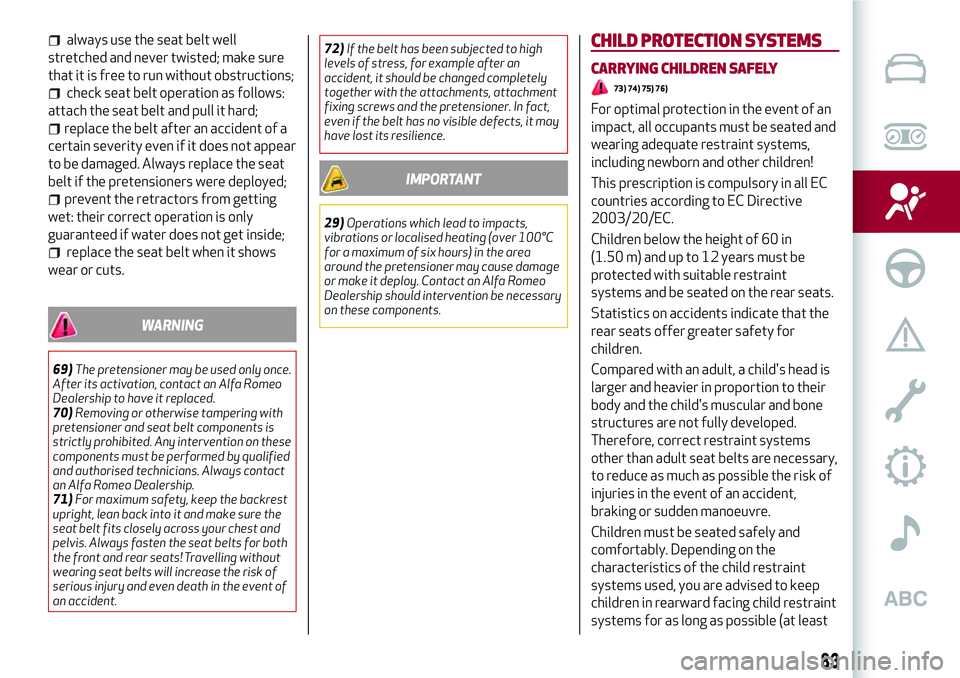
always use the seat belt well
stretched and never twisted; make sure
that it is free to run without obstructions;
check seat belt operation as follows:
attach the seat belt and pull it hard;
replace the belt after an accident of a
certain severity even if it does not appear
to be damaged. Always replace the seat
belt if the pretensioners were deployed;
prevent the retractors from getting
wet: their correct operation is only
guaranteed if water does not get inside;
replace the seat belt when it shows
wear or cuts.
WARNING
69)The pretensioner may be used only once.
After its activation, contact an Alfa Romeo
Dealership to have it replaced.
70)Removing or otherwise tampering with
pretensioner and seat belt components is
strictly prohibited. Any intervention on these
components must be performed by qualified
and authorised technicians. Always contact
an Alfa Romeo Dealership.
71)For maximum safety, keep the backrest
upright, lean back into it and make sure the
seat belt fits closely across your chest and
pelvis. Always fasten the seat belts for both
the front and rear seats! Travelling without
wearing seat belts will increase the risk of
serious injury and even death in the event of
an accident.72)If the belt has been subjected to high
levels of stress, for example after an
accident, it should be changed completely
together with the attachments, attachment
fixing screws and the pretensioner. In fact,
even if the belt has no visible defects, it may
have lost its resilience.
IMPORTANT
29)Operations which lead to impacts,
vibrations or localised heating (over 100°C
for a maximum of six hours) in the area
around the pretensioner may cause damage
or make it deploy. Contact an Alfa Romeo
Dealership should intervention be necessary
on these components.
CHILD PROTECTIONSYSTEMS
CARRYING CHILDREN SAFELY
73) 74) 75) 76)
For optimal protection in the event of an
impact, all occupants must be seated and
wearing adequate restraint systems,
including newborn and other children!
This prescription is compulsory in all EC
countries according to EC Directive
2003/20/EC.
Children below the height of 60 in
(1.50 m) and up to 12 years must be
protected with suitable restraint
systems and be seated on the rear seats.
Statistics on accidents indicate that the
rear seats offer greater safety for
children.
Compared with an adult, a child's head is
larger and heavier in proportion to their
body and the child's muscular and bone
structures are not fully developed.
Therefore, correct restraint systems
other than adult seat belts are necessary,
to reduce as much as possible the risk of
injuries in the event of an accident,
braking or sudden manoeuvre.
Children must be seated safely and
comfortably. Depending on the
characteristics of the child restraint
systems used, you are advised to keep
children in rearward facing child restraint
systems for as long as possible (at least
83